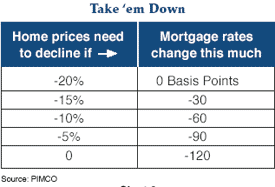
Bill Gross of PIMCO, the world’s largest bond fund in his monthly column releases his April article a few days early (avoiding April Fool’s day? Because the message can’t wait?) called Grim Reality.
Please read his article when you can.
>The problem with housing, however, is not the frequently heralded increase in subprime delinquencies or defaults. Of course write-offs, CDO price drops, and even corporate bankruptcies of subprime originators and servicers will not help an already faltering U.S. economy. But foreclosure losses as a percentage of existing loans will be small and the majority of homeowners have substantial amounts of equity in their homes. Because this is the reality of our U.S. housing market, analysts and pundits now claim we’re out of the woods: the subprime crisis is or has been isolated and identified for what it is – a small part of the U.S. economy.
>It will not be loan losses that threaten future economic growth, however, but the tightening of credit conditions that are in part a result of those losses. To a certain extent this reluctance to extend credit is a typical response to end-of-cycle exuberance run amok. And if one had to measure this cycle’s exuberance on a scale of 1-10, double-digits would be the overwhelming vote. Anyone could get a loan because shabby credits were ultimately being camouflaged within CDOs that in turn were being sold to unsophisticated foreign lenders in need of yield as opposed to ¼% bank deposits (read Japan/Yen carry trade). But there is something else in play now that resembles in part the Carter Administration’s Depository Institutions and Monetary Control Act of 1980. Lender fears of potential new regulations can do nothing but begin to restrict additional lending at the margin, as will headlines heralding alleged predatory lending practices in recent years. After doubling over 18 months between 2005 and the first half of 2006, non-traditional loan growth has recently turned negative, and lenders’ attitudes are turning decidedly conservative
In order to return to affordability levels of 2003, he illustrates how much rates and prices need to adjust to reach equilibrium. He concludes:
>if home prices in the U.S. have peaked, and are expected to stay below that peak on a real price basis for the next three years, then the Fed will cut rates and cut them significantly over the next few years in order to revigorate an anemic U.S. economy.
In other words, to get to where we were, something has got to give in the national housing market. All this talk about inflation concerns is a distraction as the impact on the housing market gradually takes hold of the US economy. The Fed will have to do something about it soon. Perhaps thats why there is only a 50% probability of the FOMC holding interest rates firm by their August meeting.
4 Comments
Comments are closed.


Big Ben is going to need some mega doses of Prosac.
Housing is screwed either way. Lower rates the dollar is going to tank and inflation is going to soar. leave rates the same housing prices will adjust downwards very slowly for a long time.
Okay, it took me a minute to get my head around this, and I might still not have it straight, but here’s the real beauty of this situation (and I’m being a bit sarcastic).
So, homeowners – the vast majority who will be able to hold onto their homes, that is – will come out ahead. Way ahead.
Bill Gross says that one of two things needs to happen to protect our economy – lower home prices or lower interest rates. Either one will correct the abnormal “bubble” of housing appreciation we had from 2004 – 2006, which was partially (mostly?) caused by loose lending guidelines.
Gross’ prediction is that #2 will happen – the Fed will lower interest rates.
Who benefits? Well, surprisingly, current homeowners. If the Fed lowers the cost of borrowing, then buyers will stay in the market (or return, depending on your perspective). This means sellers won’t need to lower their prices (or, not as much, at least).
I’m not saying it clearly, but what I mean is, if the Fed takes care of making borrowing more affordable, then it negates the need for sellers to lower their prices – they end up being able to bank all that price appreciation.
Who gets hurt? Well, those who lose their homes, of course. Sellers, on the other hand, come out of it in pretty good shape. And, buyers do, too. If they were holding off for two or three years because of high home prices, they can now borrow at lower rates … plus, they’ve had three years time to increase their salaries, etc. They earn more, and their borrowing costs are less.
I find this kind of odd, and a bit funny, actually.
John – Exactly! Except its not quite as rosey. The downtick in mortgage rates will be in response to weak economic conditions nationally. In other words, falling rates will help keep the status quo and not fuel any kind of housing revival. Of course now that gasoline prices are spiking, all this theory could go out the window.
Well, I realized after I wrote it that Bill Gross is talking about short-term rates being lowered, which only indirectly affects mortgage loan rates.
I’m still optimistic about the direction of the economy.
The only thing I fear is war. Like, a big war. Failing that, blue skies ahead.